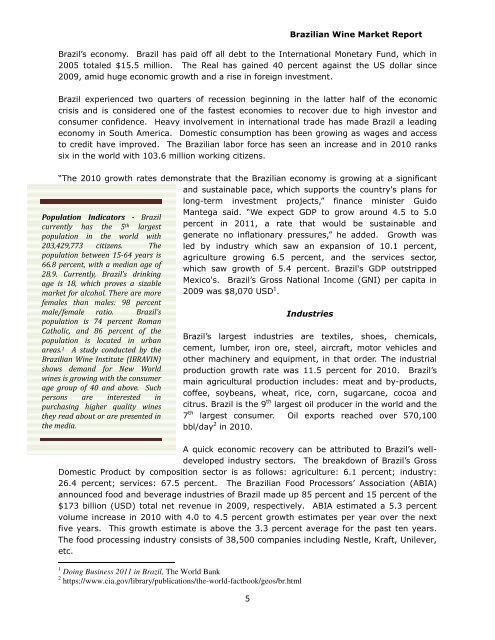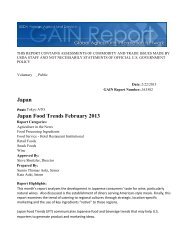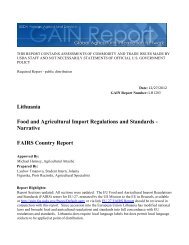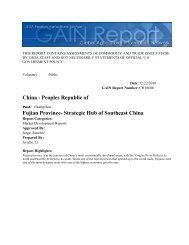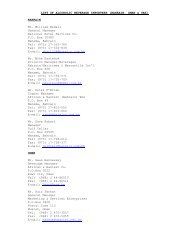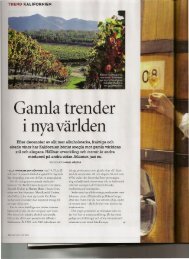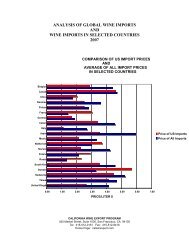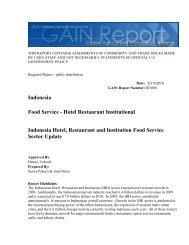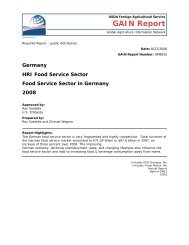Brazil Wine Market Report JBC EMP July 2011 - California Wine ...
Brazil Wine Market Report JBC EMP July 2011 - California Wine ...
Brazil Wine Market Report JBC EMP July 2011 - California Wine ...
You also want an ePaper? Increase the reach of your titles
YUMPU automatically turns print PDFs into web optimized ePapers that Google loves.
5<br />
<strong>Brazil</strong>ian <strong>Wine</strong> <strong>Market</strong> <strong>Report</strong><br />
<strong>Brazil</strong>’s economy. <strong>Brazil</strong> has paid off all debt to the International Monetary Fund, which in<br />
2005 totaled $15.5 million. The Real has gained 40 percent against the US dollar since<br />
2009, amid huge economic growth and a rise in foreign investment.<br />
<strong>Brazil</strong> experienced two quarters of recession beginning in the latter half of the economic<br />
crisis and is considered one of the fastest economies to recover due to high investor and<br />
consumer confidence. Heavy involvement in international trade has made <strong>Brazil</strong> a leading<br />
economy in South America. Domestic consumption has been growing as wages and access<br />
to credit have improved. The <strong>Brazil</strong>ian labor force has seen an increase and in 2010 ranks<br />
six in the world with 103.6 million working citizens.<br />
“The 2010 growth rates demonstrate that the <strong>Brazil</strong>ian economy is growing at a significant<br />
and sustainable pace, which supports the country's plans for<br />
long-term investment projects,” finance minister Guido<br />
Population Indicators - <strong>Brazil</strong><br />
currently has the 5 th largest<br />
population in the world with<br />
203,429,773 citizens. The<br />
population between 15-64 years is<br />
66.8 percent, with a median age of<br />
28.9. Currently, <strong>Brazil</strong>’s drinking<br />
age is 18, which proves a sizable<br />
market for alcohol. There are more<br />
females than males: 98 percent<br />
male/female ratio. <strong>Brazil</strong>’s<br />
population is 74 percent Roman<br />
Catholic, and 86 percent of the<br />
population is located in urban<br />
areas. 1 A study conducted by the<br />
<strong>Brazil</strong>ian <strong>Wine</strong> Institute (IBRAVIN)<br />
shows demand for New World<br />
wines is growing with the consumer<br />
age group of 40 and above. Such<br />
persons are interested in<br />
purchasing higher quality wines<br />
they read about or are presented in<br />
the media.<br />
Mantega said. “We expect GDP to grow around 4.5 to 5.0<br />
percent in <strong>2011</strong>, a rate that would be sustainable and<br />
generate no inflationary pressures,” he added. Growth was<br />
led by industry which saw an expansion of 10.1 percent,<br />
agriculture growing 6.5 percent, and the services sector,<br />
which saw growth of 5.4 percent. <strong>Brazil</strong>'s GDP outstripped<br />
Mexico's. <strong>Brazil</strong>’s Gross National Income (GNI) per capita in<br />
2009 was $8,070 USD 1 .<br />
Industries<br />
<strong>Brazil</strong>’s largest industries are textiles, shoes, chemicals,<br />
cement, lumber, iron ore, steel, aircraft, motor vehicles and<br />
other machinery and equipment, in that order. The industrial<br />
production growth rate was 11.5 percent for 2010. <strong>Brazil</strong>’s<br />
main agricultural production includes: meat and by-products,<br />
coffee, soybeans, wheat, rice, corn, sugarcane, cocoa and<br />
citrus. <strong>Brazil</strong> is the 9 th largest oil producer in the world and the<br />
7 th largest consumer. Oil exports reached over 570,100<br />
bbl/day 2 in 2010.<br />
A quick economic recovery can be attributed to <strong>Brazil</strong>’s welldeveloped<br />
industry sectors. The breakdown of <strong>Brazil</strong>’s Gross<br />
Domestic Product by composition sector is as follows: agriculture: 6.1 percent; industry:<br />
26.4 percent; services: 67.5 percent. The <strong>Brazil</strong>ian Food Processors’ Association (ABIA)<br />
announced food and beverage industries of <strong>Brazil</strong> made up 85 percent and 15 percent of the<br />
$173 billion (USD) total net revenue in 2009, respectively. ABIA estimated a 5.3 percent<br />
volume increase in 2010 with 4.0 to 4.5 percent growth estimates per year over the next<br />
five years. This growth estimate is above the 3.3 percent average for the past ten years.<br />
The food processing industry consists of 38,500 companies including Nestle, Kraft, Unilever,<br />
etc.<br />
1 Doing Business <strong>2011</strong> in <strong>Brazil</strong>, The World Bank<br />
2 https://www.cia.gov/library/publications/the-world-factbook/geos/br.html


